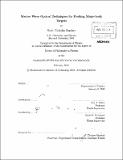| dc.contributor.advisor | Eric J. Heller and David E. Pritchard. | en_US |
| dc.contributor.author | Sanders, Scott Nicholas | en_US |
| dc.contributor.other | Massachusetts Institute of Technology. Dept. of Physics. | en_US |
| dc.date.accessioned | 2011-05-23T18:03:22Z | |
| dc.date.available | 2011-05-23T18:03:22Z | |
| dc.date.copyright | 2010 | en_US |
| dc.date.issued | 2010 | en_US |
| dc.identifier.uri | http://hdl.handle.net/1721.1/63020 | |
| dc.description | Thesis (Ph. D.)--Massachusetts Institute of Technology, Dept. of Physics, 2010. | en_US |
| dc.description | Cataloged from PDF version of thesis. | en_US |
| dc.description | Includes bibliographical references (p. 137-139). | en_US |
| dc.description.abstract | This thesis reports on our investigation of the uses of matter waves to probe many-body targets. We begin by discussing decoherence in an atom interferometer, in which a free gas acts as a refractive medium for a matter wave. The correlations that develop between the probe and the gas reduce the contrast of the interference pattern that forms when the arms of the interferometer recombine. This is due to the availability of partial which-way information left in the disturbed state of the gas. We show that the coherent part of the probe is completely unscattered, though it is phase shifted. This recoil free process leaves both the probe atom and the gas in an unchanged state, but allows for the acquisition of a phase shift. Our work elucidates the actual microscopic, many-body, quantum mechanical scattering mechanism that determines the phase shift and the decoherence of a matter wave passing through a free gas. In the second part of this thesis, we turn our attention to another complex, many-body system, comprised of ultracold atoms in an optical lattice. We investigate non-destructive techniques for probing the superfluid to Mott insulator transition by studying the scattering cross section of the cold atoms for matter waves. We show that the angular cross section of the target lattice for a matter wave depends strongly on the many-body phase of the atoms in the lattice. Finally, we discuss an interferometric technique for probing the local number fluctuations of atoms in the lattice. | en_US |
| dc.description.statementofresponsibility | by Scott Nicholas Sanders. | en_US |
| dc.format.extent | 139 p. | en_US |
| dc.language.iso | eng | en_US |
| dc.publisher | Massachusetts Institute of Technology | en_US |
| dc.rights | M.I.T. theses are protected by
copyright. They may be viewed from this source for any purpose, but
reproduction or distribution in any format is prohibited without written
permission. See provided URL for inquiries about permission. | en_US |
| dc.rights.uri | http://dspace.mit.edu/handle/1721.1/7582 | en_US |
| dc.subject | Physics. | en_US |
| dc.title | Matter wave optical techniques for probing many-body targets | en_US |
| dc.type | Thesis | en_US |
| dc.description.degree | Ph.D. | en_US |
| dc.contributor.department | Massachusetts Institute of Technology. Department of Physics | |
| dc.identifier.oclc | 720938478 | en_US |
